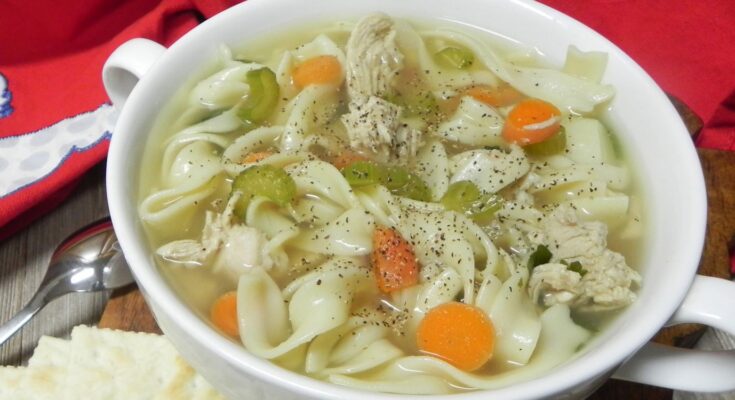Turkey Noodle Soup Recipe: There’s just something magical about a bowl of turkey noodle soup. Maybe it’s the savory aroma that fills the kitchen as it simmers on the stove, or the way it warms you up from the inside out. This soup isn’t just food; it’s a feeling. It’s the hug you need after a long day or the remedy that eases a winter cold. The rich, hearty flavor of turkey combined with soft noodles and fresh veggies creates a classic that hits every comforting note.
Turkey noodle soup has stood the test of time for a reason. It’s deeply nourishing, budget-friendly, and incredibly versatile. Whether you’re feeding a family, looking to make use of leftovers, or just craving something wholesome, this dish delivers. You’ll find variations of this soup in kitchens around the world, each adding its own twist—but the foundation remains the same: warmth, flavor, and simplicity.
The Perfect Use for Leftover Turkey
Thanksgiving might come once a year, but leftover turkey? That’s where the real meal magic happens. Instead of reheating slices of turkey breast for days, transform your leftovers into something brand new. Turkey noodle soup is the ideal next act for that roast bird—it’s not just resourceful, it’s delicious.
By shredding the meat and simmering it into a rich broth, you breathe new life into leftovers. Plus, making a soup out of leftovers means you’re reducing waste and creating a nourishing meal at the same time. Whether it’s post-holiday or a Sunday dinner that left you with extras, this recipe is your go-to.
Ingredients You’ll Need
Essential Ingredients for the Base
Let’s break down what you need to get started. Here’s a list of core ingredients that will bring this comforting soup to life:
- Cooked turkey – shredded or chopped into bite-sized pieces
- Egg noodles – these hold up beautifully in the broth
- Carrots – peeled and sliced thin for sweetness and texture
- Celery – adds crunch and depth
- Onion – yellow or white, finely diced
- Garlic – minced, for that aromatic punch
- Chicken or turkey broth – the rich foundation of your soup
- Olive oil or butter – for sautéing the veggies
- Salt and black pepper – for basic seasoning
- Thyme and bay leaf – classic herbs that infuse flavor
These ingredients form the heart of the soup. It’s a combination of texture, flavor, and nutrition that makes it irresistible.
Optional Add-Ins for Extra Flavor
Want to take things to the next level? Consider these add-ins:
- Fresh parsley – chopped and added just before serving for a fresh finish
- Lemon juice – a splash adds brightness
- Peas or corn – for a pop of color and sweetness
- Cream – a swirl makes it luxuriously creamy
- Red pepper flakes – if you like a little heat
Don’t be afraid to experiment with what’s in your fridge. Turkey noodle soup is incredibly forgiving and flexible.
Equipment Required
Basic Kitchen Tools
You don’t need a gourmet kitchen to pull this off. Just a few basic tools:
- Large stockpot or Dutch oven – deep enough to hold all your soup
- Wooden spoon or spatula – for stirring
- Sharp knife and cutting board – for prepping veggies and turkey
- Measuring cups and spoons – to keep your portions just right
Helpful Additions for Efficiency
If you’re looking to streamline the process or batch-cook:
- Soup ladle – makes serving cleaner and easier
- Storage containers – for leftovers or freezing
- Colander or strainer – handy if you rinse noodles or herbs
These tools aren’t must-haves, but they’ll definitely make your cooking experience smoother.
Step-by-Step Cooking Instructions
Now for the fun part—let’s get cooking! Follow these simple steps and you’ll have a delicious pot of turkey noodle soup in under an hour.
Step 1: Prepping the Ingredients
First things first—wash, chop, and measure everything out. This prep step saves time later and keeps you from scrambling once things start heating up.
- Dice your onion, carrots, and celery into uniform pieces so they cook evenly.
- Mince the garlic for an aromatic kick.
- Shred the turkey into bite-sized chunks.
- Set out all your spices and herbs.
If you’re using homemade broth, strain it now and keep it warm on the stove.
Pro tip: Prep like a chef—keep your ingredients in small bowls or ramekins. It makes the cooking process much smoother.
Step 2: Making the Broth
In your large stockpot or Dutch oven, heat 1–2 tablespoons of olive oil or butter over medium heat. Add the onions, carrots, and celery, and sauté for 5–7 minutes until they begin to soften.
Next, toss in the garlic and cook for another 30 seconds until fragrant.
Now, pour in your broth—about 8 cups—and bring it to a gentle boil. Toss in the thyme, bay leaf, and season with salt and pepper. Let this simmer for 10–15 minutes. This is where the flavors start to come together.
The broth is your soup’s foundation, so don’t rush it. Let those herbs and veggies infuse every spoonful with deep, savory flavor.
Step 3: Adding Vegetables and Seasoning
By now, your kitchen should be smelling like absolute heaven. With your broth simmering and veggies starting to soften, it’s time to dial up the flavor even more.
Carefully add your shredded turkey into the pot. Make sure it’s well-distributed throughout the broth. Then, check your seasoning—add more salt and pepper if needed. If you enjoy a bit of zing, now’s the time to squeeze in a little lemon juice or throw in a dash of red pepper flakes.
Let everything simmer together for another 10 minutes. This allows the turkey to absorb the flavors of the broth while staying juicy and tender. If you’re including any frozen peas or corn, stir them in during the last five minutes. They’ll add color, a touch of sweetness, and a little pop with every bite.
Remember: seasoning is personal. Taste as you go and adjust things to suit your preferences. Want more herbs? Sprinkle in some dried rosemary or parsley. Like it creamy? Add a splash of heavy cream at the very end. This is your soup—make it yours.
Step 4: Cooking the Noodles
Let’s talk noodles. The type of noodle you choose can make or break the texture of the soup. Egg noodles are the most traditional pick—they’re soft, rich, and soak up flavors beautifully. But if you have other pasta types on hand, feel free to use them.
Here’s how to cook them:
- Bring a separate pot of salted water to a boil.
- Add your noodles and cook according to the package instructions—usually 6 to 8 minutes.
- Drain and rinse with cool water to stop the cooking process.
You might be wondering: why not just cook the noodles directly in the soup? Great question. While that’s an option, cooking them separately prevents the noodles from getting mushy or soaking up too much broth, especially if you’re planning leftovers. It also keeps the broth clearer and more flavorful.
Once the noodles are cooked and drained, set them aside to be added right before serving.
Step 5: Mixing Everything Together
It’s time to bring all the components together. Add your cooked noodles into the pot of broth, turkey, and vegetables. Stir gently to combine and let everything mingle for a few minutes over low heat.
Now take a taste—this is your final chance to tweak. Need more salt? A dash of cracked pepper? A bit more lemon juice to brighten it up? Go ahead.
Once you’re happy with the taste, turn off the heat and let the soup sit for 5 minutes. This lets the flavors settle and blend together beautifully.
To serve, ladle the soup into bowls, garnish with fresh parsley, and maybe a slice of crusty bread on the side. There’s really nothing better.
Tips for the Best Turkey Noodle Soup
Now that your soup is ready, let’s talk about how to make it even better next time. Here are some golden tips:
- Use homemade broth if possible. It’s richer and more flavorful than store-bought.
- Don’t overcook the noodles—al dente is perfect so they hold their shape.
- Sauté your veggies before adding them to the broth. This step deepens the flavor.
- Add herbs at the right time. Dried herbs can go in early, but fresh herbs are best added just before serving.
- Rest before serving. Let the soup sit for a few minutes off the heat—this enhances the flavor.
Mistakes to Avoid
- Adding noodles too early – they’ll soak up all the broth and get soggy.
- Over-seasoning at the beginning – flavors intensify as the soup cooks.
- Not tasting as you go – every batch is different, so adjust flavors often.
- Forgetting acid – lemon juice or vinegar can balance richness with brightness.
Little tweaks go a long way in soup making. Trust your taste buds and don’t be afraid to experiment!
Customization Ideas
Let’s be real—one of the best things about turkey noodle soup is how easily you can make it your own. Whether you’ve got dietary restrictions, picky eaters, or just want to change things up, there are endless ways to customize this cozy classic.
Low-Carb and Gluten-Free Options
Trying to keep it light or accommodate allergies? No problem. Here are some swaps that still pack a ton of flavor:
- Zoodles (zucchini noodles): A fantastic low-carb alternative. Spiralize fresh zucchini and toss it in during the last 2–3 minutes of cooking. They soften quickly and absorb the soup’s flavor beautifully.
- Shirataki noodles: These zero-carb noodles made from konjac root are great if you’re going keto. Just rinse well and heat through.
- Gluten-free pasta: Tons of brands offer gluten-free egg noodles, rice noodles, or quinoa pasta that can sub right in.
- Cauliflower rice: A spoonful or two can mimic the body of noodles without the carbs.
Even with these swaps, you still get a warm, satisfying meal that doesn’t compromise on comfort.
Kid-Friendly Adjustments
Feeding a crew of little ones? Keep the flavors mild and the veggies fun:
- Chop vegetables small so they blend right in and don’t get picked out.
- Use alphabet pasta or mini shells to make it playful and familiar.
- Skip spicy add-ins like red pepper flakes and swap lemon for a splash of mild apple cider vinegar.
- Let kids customize their bowls with toppings like grated cheese or mini crackers.
When soup feels like playtime, even the pickiest eaters will dig in.
Storage and Reheating Tips
Making a big batch of soup is always a win, especially when it reheats like a dream. But there’s a right way to store and reheat it to keep those flavors fresh and the texture just right.
How to Store It Properly
Let the soup cool completely before transferring it into airtight containers. Here’s what you need to know:
- Refrigerate for up to 4 days. Store the noodles separately, if possible, to avoid them getting soggy.
- Freeze in individual portions for up to 3 months. Leave about an inch of headspace in your containers to allow for expansion.
If freezing, skip adding the noodles until you’re ready to eat. Cook fresh ones and add them in after reheating for best results.
Reheating Without Losing Flavor
Here’s how to reheat your turkey noodle soup without losing any of its magic:
- Stovetop: Pour the soup into a pot and warm over medium-low heat, stirring occasionally. Add a splash of broth or water if it’s too thick.
- Microwave: Place in a microwave-safe bowl, cover loosely, and heat in 1-minute intervals, stirring in between.
Avoid boiling the soup again—it can make the turkey tough and the noodles mushy. Gentle reheating is key.
Serving Suggestions
You’ve got the soup. Now what do you serve with it? Whether it’s dinner for one or feeding a table of guests, here are a few ideas to round out your meal.
Best Bread Pairings
Bread and soup go together like, well… turkey and noodles. Try these favorites:
- Crusty sourdough or baguette – perfect for dunking.
- Buttered toast or garlic bread – adds a delicious crunch.
- Cheddar biscuits – soft, cheesy, and irresistible.
If you’re feeling extra fancy, brush your bread with a little olive oil, sprinkle with herbs, and toast until golden. The contrast of crispy bread and steamy soup is unbeatable.
What to Serve on the Side
Keep it light and fresh with simple sides:
- Mixed green salad with vinaigrette to cut through the richness.
- Roasted vegetables for a warm, hearty side.
- Fruit salad to balance out the savory notes.
Of course, turkey noodle soup is filling enough to stand alone. But when you want to elevate the experience, these sides make it feel like a full-course meal.
FAQs about Turkey Noodle Soup Recipe
Q1: Can I use leftover turkey for this recipe?
Absolutely! This soup is a leftover turkey glow-up. Just shred the meat and toss it in—you’ll cut prep time in half.
Q2: What kind of noodles work best?
Egg noodles are the classic go-to. They hold up well in broth and soak in the flavor beautifully. But feel free to swap in rotini, spaghetti, or even rice noodles if that’s your vibe.
Q3: Can I make this soup ahead of time?
Yes, and it actually tastes better the next day. Just store the noodles separately to avoid them going soggy. Reheat gently to keep the turkey tender.
Q4: Can I freeze turkey noodle soup?
Totally. Just cool it down completely, leave out the noodles, and store it in freezer-safe containers. Add fresh noodles when you reheat for best texture.
Q5: How do I make it gluten-free?
Use gluten-free pasta and double-check your broth label. That’s it—you’re in the clear.
Q6: What veggies go best in turkey noodle soup?
Classic combo: carrots, celery, and onions. But you can get creative—think mushrooms, spinach, or even peas for a sweet pop.
Q7: Can I make it creamy instead of brothy?
Oh yes. Stir in a splash of cream or milk at the end, or whisk in a little flour-and-butter roux if you want a thicker vibe.
Q8: How long does it take to cook?
From start to slurp? About 30 minutes, give or take. It’s a weeknight winner.
Conclusion
There you have it—the ultimate turkey noodle soup recipe, step by step. This cozy, comforting classic is more than just a way to use up leftovers. It’s a soul-soothing, flavor-packed meal that’s perfect for chilly nights, sick days, or any time you need a taste of home.
With just a few simple ingredients and a little bit of love, you can turn a humble pot of soup into something truly special. And with all the tips, tricks, and variations we’ve covered, you’ll be ready to make this recipe your own, again and again.
So grab that ladle, pour yourself a warm bowl, and enjoy the comfort of homemade turkey noodle soup—you’ve earned it.



